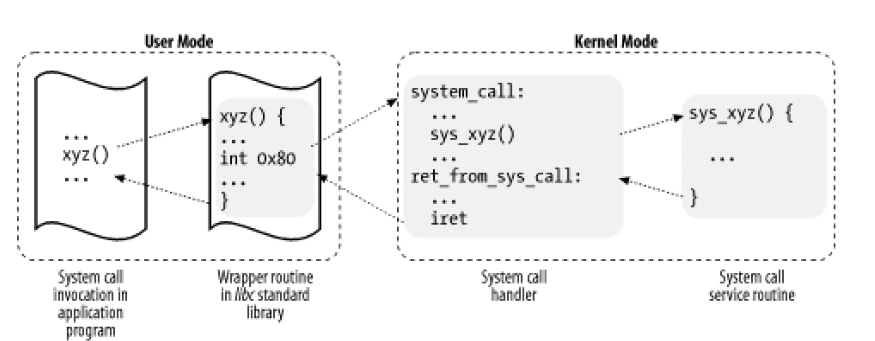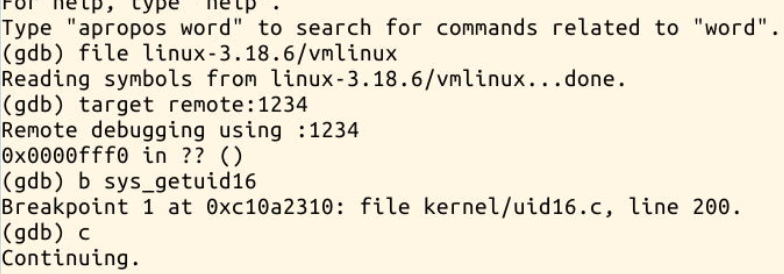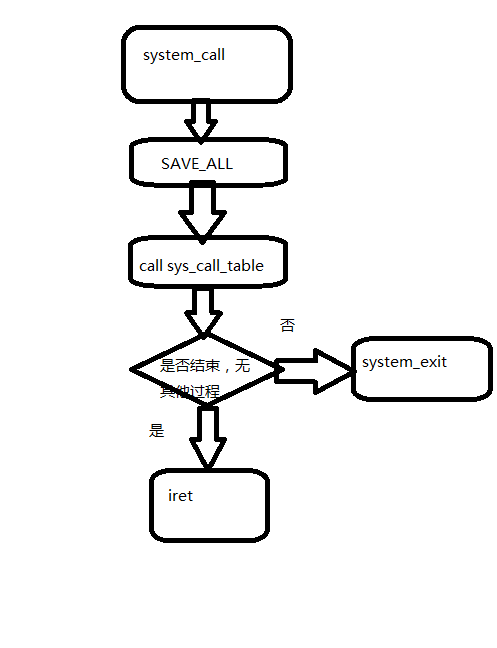李俊锋 + 原创作品转载请注明出处 + 《Linux内核分析》MOOC课程http://mooc.study.163.com/course/USTC-1000029000
一.实验原理
1.应用程序、封装例程、系统调用处理程序及系统调用服务例程之间的关系

2.在Linux中是通过执行int $0x80来执行系统调用的,这条汇编指令产生向量为128的编程异常
3.system_call是linux中所有系统调用的入口点,每个系统调用至少有一个参数,即由eax传递的系统调用号
4.系统调用初始化函数trap_init()完成系统调用的初始化。
二.实验步骤
1.将getuid和getuidasm两条命令添加置系统中,在test.c中添加如下代码:
1 int main() 2 { 3 PrintMenuOS(); 4 SetPrompt("MenuOS>>"); 5 MenuConfig("version","XXX V1.0(Menu program v1.0 inside)",NULL); 6 MenuConfig("quit","Quit from XXX",Quit); 7 MenuConfig("getuid","getuid",Getuid); 8 MenuConfig("getuidasm","getuidasm",GetuidAsm); 9 ExecuteMenu(); 10 }
2.将Getuid和GetuidAsm的代码加入到test.c中,代码如下图所示:
1 int Getuid(int argc, char *argv[]) 2 { 3 int uid; 4 uid =getuid(); 5 6 printf("uid is %d ",uid); 7 return 0; 8 } 9 int GetuidAsm(int argc, char *argv[]) 10 { 11 int uid; 12 //uid =getuid(); 13 asm volatile( 14 "mov $0x18,%%eax " 15 "int $0x80 " 16 "mov %%eax,%0 " 17 :"=m"(uid) 18 ); 19 printf("uid is %d ",uid); 20 return 0; 21 }
3.重新编译,如下图所示:

4.重新运行,如下图所示:

5.查看支持的命令,可见我们的两条命令已经添加置系统中,如下图所示:

6.输入getuid命令,结果如下图所示:

7.输入getuidasm命令,结果如下图所示:

8.使用gdb工具对系统进行调试,在函数sys_getuid16出下断点,如下图所示:


9.可知sys_getuid16对getuid系统调用起着关键作用,打开kernel/uid16.c 我们可以看到该函数,如下图所示:
1 SYSCALL_DEFINE0(getuid16) 2 { 3 return high2lowuid(from_kuid_munged(current_user_ns(), current_uid())); 4 }
三.实验总结
system_call的处理过程:
1.在系统调用的过程触发int 0x80中断。
2.之后执行system_call,在system_call中完成中段函数的调用。
3.system_call完整的代码如下所示:

ENTRY(system_call) RING0_INT_FRAME # can't unwind into user space anyway ASM_CLAC pushl_cfi %eax # save orig_eax SAVE_ALL GET_THREAD_INFO(%ebp) # system call tracing in operation / emulation testl $_TIF_WORK_SYSCALL_ENTRY,TI_flags(%ebp) jnz syscall_trace_entry cmpl $(NR_syscalls), %eax jae syscall_badsys syscall_call: call *sys_call_table(,%eax,4) syscall_after_call: movl %eax,PT_EAX(%esp) # store the return value syscall_exit: LOCKDEP_SYS_EXIT DISABLE_INTERRUPTS(CLBR_ANY) # make sure we don't miss an interrupt # setting need_resched or sigpending # between sampling and the iret TRACE_IRQS_OFF movl TI_flags(%ebp), %ecx testl $_TIF_ALLWORK_MASK, %ecx # current->work jne syscall_exit_work restore_all: TRACE_IRQS_IRET restore_all_notrace: #ifdef CONFIG_X86_ESPFIX32 movl PT_EFLAGS(%esp), %eax # mix EFLAGS, SS and CS # Warning: PT_OLDSS(%esp) contains the wrong/random values if we # are returning to the kernel. # See comments in process.c:copy_thread() for details. movb PT_OLDSS(%esp), %ah movb PT_CS(%esp), %al andl $(X86_EFLAGS_VM | (SEGMENT_TI_MASK << 8) | SEGMENT_RPL_MASK), %eax cmpl $((SEGMENT_LDT << 8) | USER_RPL), %eax CFI_REMEMBER_STATE je ldt_ss # returning to user-space with LDT SS #endif restore_nocheck: RESTORE_REGS 4 # skip orig_eax/error_code irq_return: INTERRUPT_RETURN .section .fixup,"ax" ENTRY(iret_exc) pushl $0 # no error code pushl $do_iret_error jmp error_code .previous _ASM_EXTABLE(irq_return,iret_exc) #ifdef CONFIG_X86_ESPFIX32 CFI_RESTORE_STATE ldt_ss: #ifdef CONFIG_PARAVIRT /* * The kernel can't run on a non-flat stack if paravirt mode * is active. Rather than try to fixup the high bits of * ESP, bypass this code entirely. This may break DOSemu * and/or Wine support in a paravirt VM, although the option * is still available to implement the setting of the high * 16-bits in the INTERRUPT_RETURN paravirt-op. */ cmpl $0, pv_info+PARAVIRT_enabled jne restore_nocheck #endif /* * Setup and switch to ESPFIX stack * * We're returning to userspace with a 16 bit stack. The CPU will not * restore the high word of ESP for us on executing iret... This is an * "official" bug of all the x86-compatible CPUs, which we can work * around to make dosemu and wine happy. We do this by preloading the * high word of ESP with the high word of the userspace ESP while * compensating for the offset by changing to the ESPFIX segment with * a base address that matches for the difference. */ #define GDT_ESPFIX_SS PER_CPU_VAR(gdt_page) + (GDT_ENTRY_ESPFIX_SS * 8) mov %esp, %edx /* load kernel esp */ mov PT_OLDESP(%esp), %eax /* load userspace esp */ mov %dx, %ax /* eax: new kernel esp */ sub %eax, %edx /* offset (low word is 0) */ shr $16, %edx mov %dl, GDT_ESPFIX_SS + 4 /* bits 16..23 */ mov %dh, GDT_ESPFIX_SS + 7 /* bits 24..31 */ pushl_cfi $__ESPFIX_SS pushl_cfi %eax /* new kernel esp */ /* Disable interrupts, but do not irqtrace this section: we * will soon execute iret and the tracer was already set to * the irqstate after the iret */ DISABLE_INTERRUPTS(CLBR_EAX) lss (%esp), %esp /* switch to espfix segment */ CFI_ADJUST_CFA_OFFSET -8 jmp restore_nocheck #endif CFI_ENDPROC ENDPROC(system_call) entry_call
4.system_call精简代码如下所示:
1 ENTRY(system_call) 2 SAVE_ALL #保存现场 3 syscall_call: 4 call *sys_call_table(,%eax,4) #中断向量表,查阅中断向量表,调用系统调用 5 syscall_after_call: 6 movl %eax,PT_EAX(%esp) # 存储返回值 7 syscall_exit: 8 LOCKDEP_SYS_EXIT 9 DISABLE_INTERRUPTS(CLBR_ANY) # 确保不会错过中断 10 restore_all: 11 TRACE_IRQS_IRET 12 irq_return: 13 INTERRUPT_RETURN 14 ENDPROC(system_call)
5.system_call流程图如下所示:

个人总结:本次实验的难度明显比之前的实验要难,而且做实验时,由于实验楼环境比较卡,因此配置实验环境可花了不少时间,希望下次实验不要遇到这么多麻烦(*^__^*)
